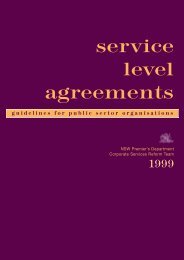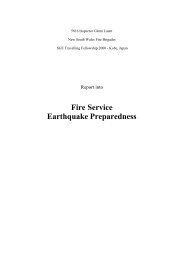Identify and respond to children and young people at risk - NSW ...
Identify and respond to children and young people at risk - NSW ...
Identify and respond to children and young people at risk - NSW ...
You also want an ePaper? Increase the reach of your titles
YUMPU automatically turns print PDFs into web optimized ePapers that Google loves.
It is essential when working with Aboriginal families <strong>to</strong> take in<strong>to</strong> account the<br />
role of community elders <strong>and</strong> <strong>to</strong> recognise the role of the extended family, with<br />
more particip<strong>at</strong>ion in day <strong>to</strong> day child rearing from gr<strong>and</strong>parents <strong>and</strong> other<br />
family members than would be the case in nuclear families.<br />
Legisl<strong>at</strong>ion <strong>to</strong> be covered in the next section acknowledges particular roles in<br />
decision making <strong>to</strong> ensure particip<strong>at</strong>ion of Aboriginal <strong>people</strong> in decisions about<br />
Aboriginal <strong>children</strong>.<br />
It is important <strong>to</strong> have an informed viewpoint about cultural practices, <strong>and</strong> <strong>to</strong><br />
ensure th<strong>at</strong> harm <strong>to</strong> <strong>children</strong> is not excused by being labeled as ‘cultural’ when<br />
it would be unacceptable <strong>to</strong> other Aboriginal <strong>people</strong>, while also being able <strong>to</strong><br />
recognise behaviours <strong>and</strong> practices th<strong>at</strong> are different <strong>and</strong> culturally based, <strong>and</strong><br />
not a cause for concern.<br />
3. Highlight th<strong>at</strong> Alan <strong>and</strong> Lily come from culturally diverse<br />
backgrounds.<br />
Ask:<br />
‘Wh<strong>at</strong> should you take in<strong>to</strong> account in working with <strong>children</strong> from<br />
culturally diverse backgrounds?’<br />
Highlight the wide range of culturally <strong>and</strong> linguistically diverse communities<br />
represented in Australia. The impact of cultural <strong>and</strong> linguistic diversity will vary<br />
widely depending on how long families have lived in Australia <strong>and</strong> their<br />
experiences before <strong>and</strong> after arriving.<br />
Particular challenges may be experienced by emerging communities whose<br />
members are recent arrivals so th<strong>at</strong> parents may not have ready access <strong>to</strong><br />
support workers who speak their language <strong>and</strong> underst<strong>and</strong> their culture.<br />
Families may be unfamiliar with Australian expect<strong>at</strong>ions about child safety,<br />
welfare <strong>and</strong> wellbeing, such as expect<strong>at</strong>ions around physical discipline <strong>and</strong><br />
supervision. Workers may play a role in educ<strong>at</strong>ion in this respect.<br />
Migr<strong>at</strong>ion is a challenging experience, especially for families who have arrived<br />
as refugees. Families may maintain a strong sense of responsibility for family<br />
members they have left behind, including sending money <strong>to</strong> them, <strong>and</strong><br />
prioritising efforts <strong>to</strong> support those family members so they <strong>to</strong>o can migr<strong>at</strong>e <strong>to</strong><br />
Australia. Families may experience significant financial <strong>and</strong> social stress, with<br />
impacts on parenting <strong>and</strong> <strong>children</strong>.<br />
Migrants, in particular refugees who have experienced war <strong>and</strong> political<br />
oppression <strong>and</strong> discrimin<strong>at</strong>ion, may experience ongoing effects of trauma,<br />
including symp<strong>to</strong>ms of post-traum<strong>at</strong>ic stress disorder such as flashbacks. These<br />
may impact on a parent’s capacity <strong>to</strong> manage the stresses of daily life.<br />
In assessing whether unfamiliar behaviours or practices are concerns in rel<strong>at</strong>ion<br />
<strong>to</strong> a child or <strong>young</strong> person’s safety, welfare <strong>and</strong> wellbeing, it is important <strong>to</strong><br />
consider the child or <strong>young</strong> person’s experience, <strong>and</strong> <strong>to</strong> seek advice from <strong>people</strong><br />
within the community or those experienced in working with families from th<strong>at</strong><br />
community, <strong>to</strong> ensure th<strong>at</strong> harm <strong>to</strong> <strong>children</strong> is not minimised, <strong>and</strong> th<strong>at</strong> culturally<br />
diverse practices th<strong>at</strong> are not harmful <strong>to</strong> <strong>children</strong> are accepted <strong>and</strong> supported.<br />
Impacts of migr<strong>at</strong>ion can persist in<strong>to</strong> subsequent gener<strong>at</strong>ions. Beliefs <strong>and</strong><br />
practices of Australian born parents may be impacted by the influence of<br />
gr<strong>and</strong>parents who were born overseas.<br />
Keep Them Safe CHCCHILD401A – Facilita<strong>to</strong>r’s Manual<br />
© The <strong>NSW</strong> Technical <strong>and</strong> Further Educ<strong>at</strong>ion Commission<br />
(TAFE <strong>NSW</strong> – Industry Skills Unit, Meadowbank, 2010)<br />
20







